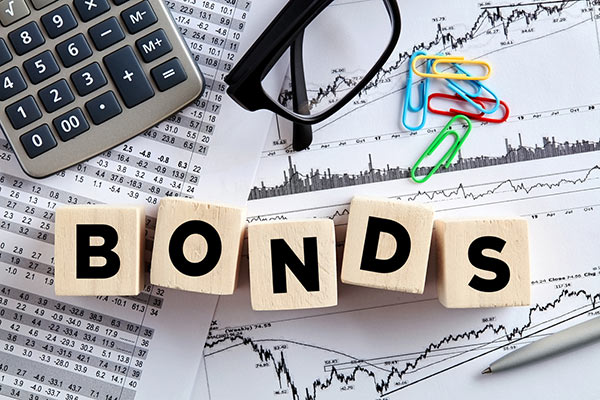ISA tips: 10 things to know before investing in bonds and bond funds
In this ISA guide, we aim to break down some of the bond barriers to help give you a broader understanding.
15th April 2025 16:42
by Sam Benstead from interactive investor

The world of bonds, also known as fixed income, can be more complicated than buying shares.
The essential elements of bonds are straightforward – investors lend their money to a government or company for a fixed period of time and are paid interest. Then, when the life of the bond ends, investors receive their money back – providing the government or company doesn’t fall into financial difficulty.
- Invest with ii: Buy Bonds | Tax Rules for Bonds & Gilts| General Investing with ii
However, there are lots of variables that makes the world of bonds more complicated, such as what happens to bond prices when interest rates rise or fall.
In this ISA guide, we aim to breakdown some of the bond barriers to help give you a broader understanding of them.
1) Bond or bond fund – which is right for you?
A bond fund owns a portfolio of bonds, so can they really be that different from owning bonds directly? The answer is a resounding yes.
The big difference is that a bond fund never matures – it reinvests cash from maturing bonds and often does not hold bonds to maturity. This means bond fund investors are not locking in a set yield, but rather owning a constantly shifting portfolio of bonds whose values, and therefore the unit price of a bond fund, will constantly change as bond prices fluctuate.
- Shares vs bonds: which offers the best opportunity for income seekers?
- Watch out video: how bonds works and why you should own some
On the other hand, investors looking to lock in a fixed income may be better served by holding a direct bond, such as gilt (UK government bond) to maturity. While the price of the bond will fluctuate, as the bond nears it maturity date it will return to its par value (the price it was when it was first issued) and pay that par value back to investors on maturity.
Gilts are easy to trade for retail investors (more on that later), but most other parts of the fixed-income universe are the exclusive realm of professional money managers, so access to these markets (like corporate bonds or floating-rate bonds) are generally best served by fund managers.
2) Understanding yields
The coupon that bonds pay is a big part of their appeal, but understanding the yield that a bond has can be tricky.
That is because yield is a reflection not just of how much income a bond pays out, but the price of the bond as well. When bond prices fall, the relative value of the fixed coupon increases, leading to a higher yield. Higher bond prices therefore do the opposite and compress yields.
There are two key yield figures to be aware of when investing in bonds: the income (or running/distribution yield), which is what investors can expect to receive annually as income, and the yield to maturity (YTM, also know as the gross redemption yield), which is the total return of a bond if held to maturity.
The calculation for the YTM factors in the par value of the bond paid back when it matures, while the running yield just looks at the coupon and the price of the bond.
Looking at a fund’s factsheet, the distribution yield is the best measure of what income you are likely to receive, while the YTM is a good indicator of what the annual total return of the portfolio offers at that moment in time.
- Bond Watch: Trump’s trade war could boost UK bonds
- The highest-yielding money market funds to park your cash in
3) How to decipher gilt names
Ready to buy gilts? The first barrier to overcome is to understand what their names are telling you. Take the popular UNITED KINGDOM 0.125 31/01/2028, which has the stock market ticker TN28.
The 0.125% indicates the coupon when the bond was issued, meaning that for every £100 invested the bond pays you 12.5p a year (issued in two payments six months apart). The 31/01/2028 refers to the date the bond matures. The London Stock Exchange website is a handy source of information for finding out more about a gilt, such as when the coupons are paid.
Remember, the yield on the gilt is not the yield when it was issued, but rather a calculation based on the price of the bond and the coupon paid. If the bond price has fallen since launch, then the yield will be greater than the initial coupon, and a higher bond price would mean a lower yield. Gilts usually begin trading around £100.
4) How to buy gilts directly
Previously locked out of gilt auctions, ii customers will now be able to participate and gain commission-free access to the bonds when they are issued.
Once issued, gilts are listed on the London Stock Exchange and tradeable via its Order Book for Retail Bond (ORB). Remember, the price swings will affect the yield of the bond for new investors.
- Building a ‘gilt ladder’ – everything you need to know
- Everything you need to know about investing in gilts
There is a list of gilts available to buy on the ii platform here. Most gilts will trade digitally, but some, such as index-linked gilts, may require phone dealing, which is charged at the online commission rate.
The price quote online is the “clean” price, which does not factor in the accrued interest on the bond. Dealing is done at the “dirty” price, which means that investors pay a little more to compensate the current gilt holder for not receiving the next bond coupon.
There will be a bid/offer spread to buy gilts this way, but most gilts are highly liquid and the additional cost is minimal.
5) How to invest in corporate bonds directly
Compared to gilts, which retail investors can easily access, buying corporate bonds directly is more tricky. The ORB has around 50 corporate bonds (compared with 80 gilts), which are normally traded in £1,000 denominations (compared with £100 for gilts).
Like gilts, most can be traded online, at the “clean” price on our website. The list of corporate bonds available is here. They include issues from the likes of British Land, NatWest and Lloyds Bank.
Of the thousands of bonds issued by companies, only a handful are tradeable in small denominations. Most are issued in £100,000 blocks, so only large investors can access them.
However, there are changes underfoot, and we may see corporate bonds become more accessible to retail investors in the next year.

6) Jargon buster: duration, credit rating and maturities
Like other investment areas, fixed income has its own jargon to get to grips with. Duration, measured in years, is the sensitivity of a bond to change in interest rates. BlackRock says for every 1% increase or decrease in interest rates, a bond’s price will change approximately 1% in the opposite direction for every year of duration. So, a bond with a high duration will increase in value if interest rates fall more than a bond with a lower duration.
A bond’s credit rating is also something to be aware of. Less-risky bonds will have a better credit rating, as judged by third parties such as Moody’s and S&P. Anything rated BBB and above is considered “investment grade” and likely to have a very low default risk.
The maturity of a bond is simply the time until the bond matures. A longer time to maturity means the bonds are probably going to be more volatile, which is something investors should be aware of.
7) Different types of bonds to consider
The bond market is very diverse. Investors can own, via funds, debt from emerging and developed world governments, corporates, bonds where the coupon and final principal payment are linked to inflation, as well as bonds where payouts are linked to interest rate changes.
These different parts of the market will have different properties, with some offering more defensive attributes and some more offensive ones for a portfolio. Enlisting a fund manager running a “strategic” bond fund gives them licence to pick bonds from lots of different parts of the fixed-income universe. Super 60 fund Jupiter Strategic Bond is in this investment category.
- Sign up to our free newsletter for investment ideas, latest news and award-winning analysis
- Benstead on Bonds: in a worst-case scenario, can gilts deliver?
8) Active or passive bond funds
Unlike stock market passive funds that tend to buy more of companies as they grow larger (and more successful), bond funds have their biggest positions in companies or countries with the most debt. This could be interpreted as a reason not to invest, as companies with more debt may be less secure financially.
On the other hand, active funds can avoid companies that are heavily in debt and focus on more financially secure firms.
Nevertheless, there is no guarantee that active fund managers will outperform or are lower risk than a cheap passive alternative.
9) What do bonds currently yield?
Gilts yield between 4% and 5%, depending on the maturity date and if held to maturity.
Investment-grade sterling bonds yield about 5.5%, while global high-yield bonds are at about 6.5%. Emerging market bonds are at around 7%.
These are yield-to-maturity figures, so the income yield of the bonds will differ depending on which bonds a fund owns.
- What are the best alternatives to holding cash?
- Day in the life of a chief investment officer: Artemis’ Paras Anand
10) What is the outlook for bond prices?
The big factor that impacts bond prices is interest rates. This risk-free borrowing rate is set by each country’s central bank. When rates go up, it means that investors can get a better deal from newly issued bonds, and therefore they sell old bonds to lock in a better rate from a new bond.
When rates go down, this has the opposite effect. The old bonds with higher interest rates become more valuable.
This means that inflation falling and interest rate cuts this year should be good news for bond prices. However, stickier than expected inflation would be bad news, as the Bank of England would use interest rates to slow down the economy. Investors expect two or three more interest rate cuts this year in the UK.
These articles are provided for information purposes only. Occasionally, an opinion about whether to buy or sell a specific investment may be provided by third parties. The content is not intended to be a personal recommendation to buy or sell any financial instrument or product, or to adopt any investment strategy as it is not provided based on an assessment of your investing knowledge and experience, your financial situation or your investment objectives. The value of your investments, and the income derived from them, may go down as well as up. You may not get back all the money that you invest. The investments referred to in this article may not be suitable for all investors, and if in doubt, an investor should seek advice from a qualified investment adviser.
Full performance can be found on the company or index summary page on the interactive investor website. Simply click on the company's or index name highlighted in the article.
Please remember, investment value can go up or down and you could get back less than you invest. If you’re in any doubt about the suitability of a stocks & shares ISA, you should seek independent financial advice. The tax treatment of this product depends on your individual circumstances and may change in future. If you are uncertain about the tax treatment of the product you should contact HMRC or seek independent tax advice.